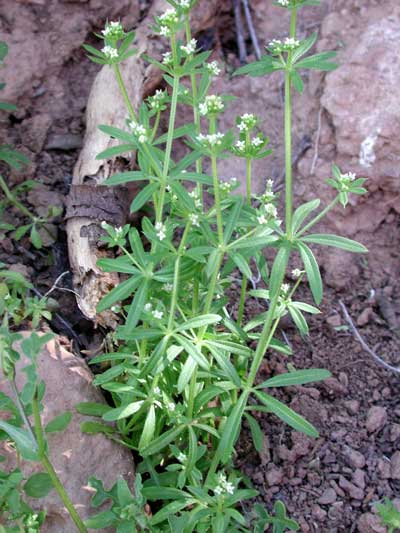Over the summer months, we'll take a look at some of the more interesting plants that can be spotted around Irish towns and countryside. The aim is to make it easy to identify at least some of them and have an understanding of their biology. The best thing you can do is to get out there and have a look yourself. We'll start with an easy one to spot and it's highly abundant - so no excuses for not being able to find it!
Goosegrass (Galium aparine) is found throughout the country in both urban and rural habitats. Dog owners will be all too familiar with the seeds of this plant -often adhering in large numbers to dogs which have managed to roll in a clump of these plants. The time taken to remove the seeds from a dogs coat can be considerable!
The plant itself can be found in many different types of habitats. Look for it on scrub or wasteland in urban and semi-urban locations. It may also be found in ditches in agricultural areas; sometimes encroaching on the planted field itself.
The plant can be recognised by touch as much as anything else given its 'velcro-like' stems. These stems are noticeably 4-angled (almost square in shape) with minute, curved prickles all over which give the distinctive velcro feel.
The leaves are arranged in groups (whorls) of between 6 and 9 narrow, pointed leaves. When they eventually flower they'll produce tiny (c. 2 mm) white flowers with four petals.
The fruits, which become evident in late summer are 2-lobed and densely covered with more of these hooked bristles. In terms of seed dispersal, goosegrass is very sucessful. The seeds will stick to animals, clothing, etc. and can be carried a large distance from the parent plant.
Goosegrass is edible*. The fruits can be roasted to make a coffee-like drink and the plant can be made into a tea which has been used by herbalists to treat blood pressure and high temperatures. The plant can be boiled and used as a leaf vegetable before the seeds appear and it makes for "tolerable eating". The tea can also be used to wash your hair and treat dandruff.
The plant can be very troublesome for farmers, reducing yield in winter wheat by 12-57% in a UK study. Because of its straggling, binding nature it can seriously interfere with the process do harvesting.
* Please note, there are inherent dangers in eating wild plants which you may not have identified correctly. If in any doubt, don't eat it and consult an expert. The medicinal claims mentioned are often just that - claims. Don't consider this article a substitute for qualified medical advice.




It's well worth taking a close look at goosegrasses's hooks under the microscope - see http://beyondthehumaneye.blogspot.com/search/label/goosegrass
ReplyDelete